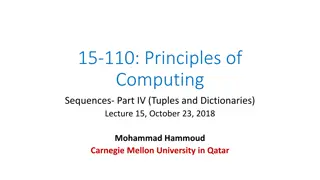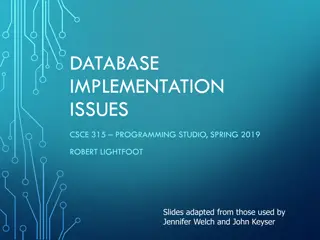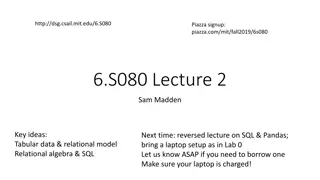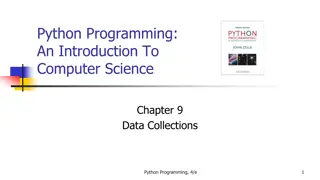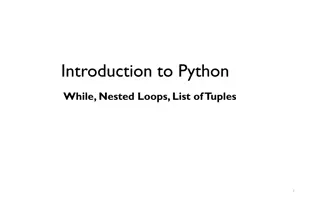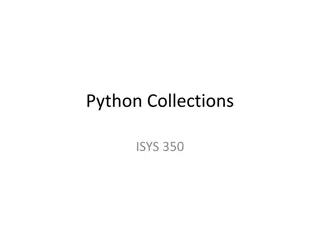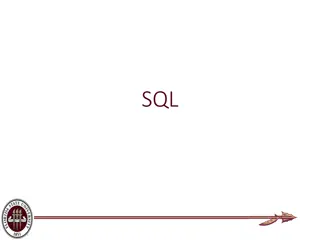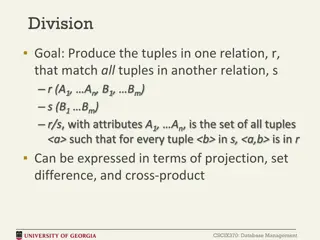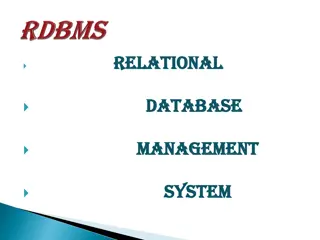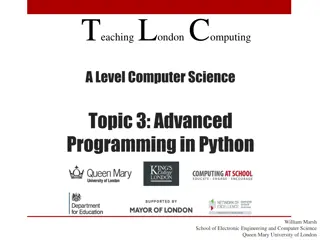Dangling Tuples
Learn about dangling tuples in DBMS, which are tuples that do not participate in a natural join, potentially indicating consistency issues in the database. Referential integrity constraints play a key role in identifying and addressing dangling tuples.
1 views • 58 slides
Environments,Tuples,& Dictionaries
Explore the concepts of environments, tuples, and dictionaries in Python through visual diagrams and explanations. Learn about how Python interprets programs, assignments, functions, and function calls within different frames and environments. Discover the rules for name lookup in user-defined funct
2 views • 27 slides
Understanding Tuples and Dictionaries in Computing Sequences
Tuples are immutable data structures similar to lists, written with round brackets. They can contain different types of elements, be sliced and indexed similarly to lists, concatenated, repeated, nested, and passed by value to functions. Examples show how tuples operate and differentiate from lists.
1 views • 21 slides
Database Implementation Issues in Programming Studio
Key topics covered in the slides include database implementation issues, storing data efficiently, and strategies for handling variable length fields in tuple storage. The presentation delves into specialized algorithms for database efficiency and reliability, terminology related to database impleme
0 views • 32 slides
Introduction to Tabular Data Modeling and SQL Concepts
Explore the fundamentals of tabular data modeling, relational algebra, SQL, and database relationships through practical examples. Learn about key concepts such as primary keys, tuples, and different types of relationships in database management. Get hands-on experience using Pandas and SQL for data
0 views • 30 slides
Exploring DS Architecture Concepts in March 2015 IEEE Document
Delve into advanced DS architecture concepts discussed in the March 2015 IEEE document by Mark Hamilton from Spectralink. The document elaborates on the basic DS model, terminology like Portal DSAF, MAC service tuples, and distributed brains, offering insights into network structures and protocols.
0 views • 11 slides
Introduction to Data Collections in Python Programming
In this introduction to computer science chapter, you will explore the use of lists, tuples, and dictionaries in Python to represent and manipulate collections of data. Learn about the functions and methods available for working with Python lists and understand how to group related values using tupl
0 views • 58 slides
Understanding Python Loops: While, Nested Loops, and List of Tuples
Python loops come in two types - definite loops (like for loops) and indefinite loops (like while loops). While loops are used for conditional iteration, repeating as long as a condition is true. On the other hand, for loops are ideal for situations where the number of iterations is known in advance
0 views • 25 slides
Understanding Python Iterators and Generators
Explore the concept of iterators and iterable objects in Python. Learn how to use iterators to access elements one by one in an iterable object. Discover the sequential access provided by iterators and how to create iterators for various iterable objects like lists, tuples, dictionaries, strings, an
0 views • 38 slides
Understanding Python Collections: Lists, Tuples, and Dictionaries
Data structures in Python such as lists, tuples, and dictionaries play a crucial role in storing and organizing data. Lists allow storing a collection of diverse data items, tuples provide immutability, and dictionaries facilitate key-value pair storage. Learn how to declare, initialize, access, and
0 views • 42 slides
Challenges and Solutions in High-Multiplicity Jet Production Studies
Theory and methodology challenges in the universality and production of W+multijet events are discussed, emphasizing the importance of accurate predictions and scale independence. The NLO revolution and on-shell methods are explored, along with software tools like BLACKHAT and SHERPA. Managing compu
0 views • 14 slides
SQL - Introduction and Basics
SQL (Structured Query Language) is a standard language for querying and manipulating data. It includes Data Definition Language (DDL) for creating, altering, and deleting tables, Data Manipulation Language (DML) for querying tables and modifying data, and more. Tables in SQL consist of attributes li
0 views • 30 slides
Understanding Division in Relational Algebra
Division in relational algebra is a fundamental operation used to produce tuples in one relation that match all tuples in another relation based on certain conditions. It involves expressing the desired result in terms of projection, set difference, and cross-product operations. The process ensures
0 views • 13 slides
Understanding SIMD in Computer Architecture
SIMD (Single Instruction Multiple Data) architecture plays a crucial role in optimizing performance for parallel computing tasks. It allows for the simultaneous processing of multiple data elements, enhancing efficiency in various applications. The concept is rooted in executing the same operation a
0 views • 24 slides
Evolution of Database Management Systems
The evolution of Database Management Systems (DBMS) began with file systems and punched cards in the 1950s, followed by hierarchical and network models in the 1960s and 1970s. The 1980s introduced relational databases like Ingres, Oracle, DB2, and Sybase. The 1990s saw the rise of object-oriented an
0 views • 31 slides
Advanced Python Programming: Arrays, Exceptions, and More
Explore advanced programming topics in Python, including arrays of multiple dimensions, Python built-in types like tuples and dictionaries, and handling exceptions. Dive into representational challenges like those in Minesweeper and Hangman, and discover the significance of arrays in programming. Le
0 views • 31 slides


